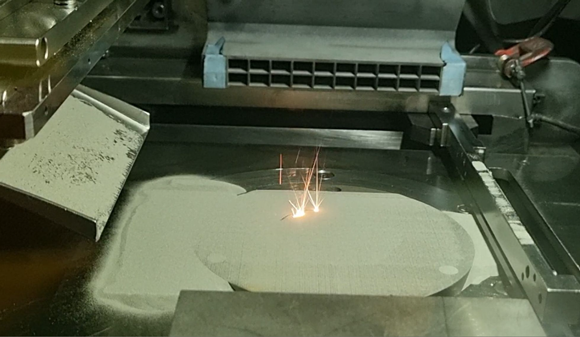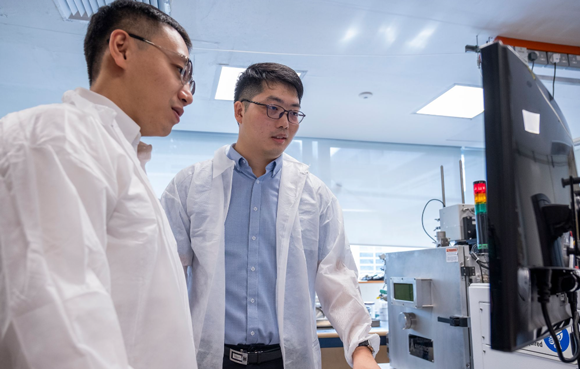New method to additively manufacture components with multiple different properties
November 14, 2023

A team of scientists from Nanyang Technological University Singapore (NTU Singapore) and the University of Cambridge, UK, have developed a new method for creating customised additively manufactured metal parts containing different properties. The new process is outlined in a paper published in Nature Communications.
The ability to create varied properties means that, when necessary, some regions of the metal can be made stronger than others. In addition, the new process should also, in theory, enable manufacturers to incorporate additional features into a part. These could include varied levels of electrical conductivity or corrosion resistance within the same metal.
The research was co-led by Professor Gao Huajian, a Distinguished University Professor at NTU Singapore, and Assistant Professor Matteo Seita from the University of Cambridge. Professor Seita was a faculty member at NTU when the study was conducted. They drew inspiration from ‘heating and beating’ methods, similar to traditional blacksmithing techniques, to develop the new process.
This prompted them to blend materials science with mechanical engineering principles. They applied Additive Manufacturing techniques, typically used to eliminate and prevent defects in additively manufactured metals. By altering microscopic structures in the metals, they were able to change their properties.
This novel method allows manufacturers to choose the type of internal microstructure they want, and therefore the specific property, as well as accurately determine its location within the metal. This is an improvement over traditional methods, which do not offer such control.
Prof Gao, from NTU’s School of Mechanical and Aerospace Engineering (MAE), shared, “Our method opens the way for designing high-performance metal parts with microstructures that can be fine-tuned to adjust the parts’ mechanical and functional properties, even at specific points, and allowing them to be shaped in complex ways with 3D printing.”
The research team includes scientists from various organisations. These include the Agency for Science, Technology and Research’s (ASTAR) Singapore Institute of Manufacturing Technology and Institute of High Performance Computing, Switzerland’s Paul Scherrer Institute, the VTT Technical Research Centre of Finland, and the Australian Nuclear Science and Technology Organisation.

Materials science meets Additive Manufacturing
The new Additive Manufacturing method was developed as an interdisciplinary solution by research fellow Dr Gao Shubo at NTU’s MAE during his PhD studies at the University.
Dr Shubo, the first author of the research paper outlining the new method, has sought a way to modify microstructures in additively manufactured metals and alter their properties without having to physically manipulate the metal.
In traditional metalwork, like blacksmithing, the ‘beating’ alters the metal’s external shape, but it can also modify the metal’s internal microstructures to enhance their strength. However, the beating process can also unintentionally damage certain features of additively manufactured metals, such as their intricate shapes and internal structures that are challenging to create with conventional methods.
Dr Shubo aimed to solve this issue. Utilising his prior training in materials science, he discovered that by causing the metal to rapidly expand and shrink during the heating and cooling stages of the AM process, the microstructures of the metal could be reconfigured.
He proposed that this could be achieved by modifying an AM machine’s energy source, such as a laser beam, to melt layers of metal powder for the Additive Manufacturing of a metal part.
While this technique controls the formation of gaps in the metal, the researchers demonstrated that modifying the laser also alters the microstructures that form in the metal post-heating. There are two types of structures: one that strengthens the metal and another that makes it mechanically weaker. Additionally, they remelted the layers of additively manufactured metal to promote the microstructure changes.
The researchers’ experiments with additively manufactured stainless steel later confirmed Dr Shubo’s theories.
Since Additive Manufacturing enables precision construction of each layer of metal, it allows the characteristics of the metal to be finely tuned at specific points. This level of control is unattainable with conventional manufacturing processes. The scientists managed to use Additive Manufacturing techniques and adjust build parameters. This allowed them to produce a metal with varying microstructures, creating stronger and weaker regions in their desired locations within the metal.
“Our strategy can target specific sites in the metal, which allows manufacturers to design and create complex microstructures that allow the properties of the metal to be customised to a degree not seen before. For instance, the same metal can have contrasting properties in the same part,” shared Dr Shubo.
In theory, the strength of an additively manufactured metal part should fall between that of materials with only strong regions and those with only weak regions. However, the research team discovered that AM metals with both strong and weak regions were marginally stronger than metals composed solely of strong regions.
This synergistic interaction between strong and weak regions in the manufactured metal suggests that the new technique could create stronger and tougher materials than those described by the classical rule-of-mixture theory for composite materials comprising different materials.
The researchers posit that their method can produce additively manufactured metal with varying functional properties. For instance, a metal part could be designed such that the section submerged in seawater exhibits increased corrosion resistance, while sections above water display reduced corrosion resistance.
Future work could involve testing whether the method can produce additively manufactured metals with different microstructure designs. This could potentially lead to metals with improved mechanical and functional properties.
The full paper is available here.
Download Metal AM magazine

















